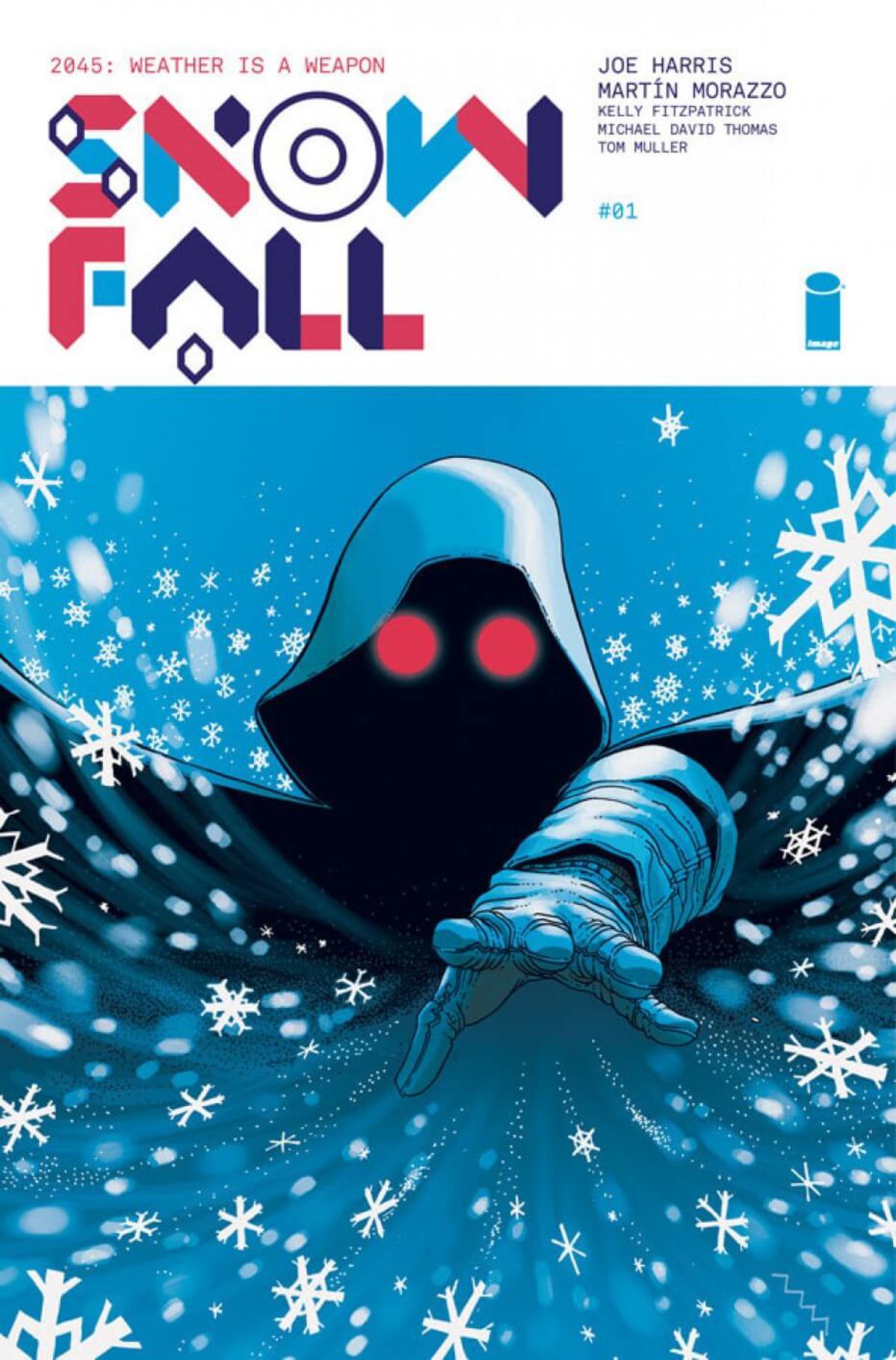In Joe Harris and Martin Morazzo's "Snowfall" #1, an eco-terrorist strikes back against a corrupt government in the aftermath of catastrophic climate change.
The story begins with a fairy-tale-like prose introduction, complemented by Morazzo's dream-like panel compositions and Michael David Thomas' italic lettering. On the first page, Morazzo's art is all shapes and symbols, and the texture of his trees and the geometric lines of his stylized snowflakes are lovely.
This sets up a strong contrast with the second page's cluttered urban landscape and Thomas' colder, sans-serif text style in the captions. The first scene set in the concrete world of "Snowfall" is slow and cinematic, allowing the reader a glimpse of a mysterious character, whose entrance is reminiscent of the Golden Age Sandman. Morazzo's landscapes and backgrounds are strong, but his faces and bodies are weaker. He draws different ages well, but most of his adult characters have overly pointy chins and small mouths.
Harris softens two information dumps by setting them up as a classroom lecture and a debriefing, but these are thin disguises. The conversation between Inspector Davitika Deal and the mayor of the New Mercy resettlement is especially heavy on exposition, but it succeeds in getting across key points.
Harris makes his moral framework for the dystopian world of "Snowfall" clear very quickly. The government is dependent upon "private sector benefactors" for its science and its police state. The villains are one-dimensional, and it seems unlikely tthey will have better rationale for their actions than the usual motivations of power and money. However, it is interesting that even this corrupt government has the hindsight to regret the Citizens United Supreme Court decision and other recent steps towards "corporate personhood."
A feeling of inevitable convergence drives the action. The prophecy-like introduction seeds suspense by foretelling a meeting between a princess and a White Wizard, and this is reinforced by Anthony Farrow's quest. Anthony's introduction via a gesture of protest works well. He's a student in search of a teacher, or a sidekick in search of his hero.
The creator of the snowfall is the most morally complex character, potentially similar to the terrorist in "V for Vendetta." The build and revelation about an injured kid has strong pacing and composition, even if it's a cliche to use children as shorthand to represent the harm to civilians.
"Snowfall" is political, concept-driven science fiction. The danger is that characters will get much shorter shrift than Harris' points about corporations, corruption and greed. Harris and Morazzo's other collaboration, "The Great Pacific," was weak on deeper characterization. "Snowfall" runs the risk of being the same: rich on landscapes and lessons but with characters that feel more like chess pieces than flesh and blood. The big stakes and themes in "Snowfall" -- freedom vs. security, truth vs. propaganda -- need characters that are either relatable or mythic and strong enough to carry the weight, or the story will feel merely didactic.
Fitzpatrick's colors don't assist with shading. The short sequence where Anthony runs around on university grounds is especially flat-looking because the direction of light isn't clear in the backgrounds. The topographical map in the diner scene has a flattering translucency, but the brick reds of Dr. Reason's house grab too much attention and work against the flow of dialogue. Morazzo's facial expressions and body language get across the basics, but they don't sustain heightened dramatic tension when Anthony finds the person he's looking for, and the tilted perspective in some panels only make the scene more difficult to follow without creating excitement.
Harris gets realism points for Dr. Reasons' initial caginess, but -- when the doctor starts talking freely -- he sounds like a B-movie supervillain. There's a good twist about who's behind the mysterious snowfall, but its impact is deflated by melodramatic and cliched imagery. Dr. Reasons falls on his knees after yelling "NO," and Morazzo's facial expressions and body language are too over-the-top, especially when no irony or parody seems to be intended.
Despite this, Harris' structure and plotting for "Snowfall" is strong, and the solid pacing may be even smoother in future issues when the exposition is out of the way.

